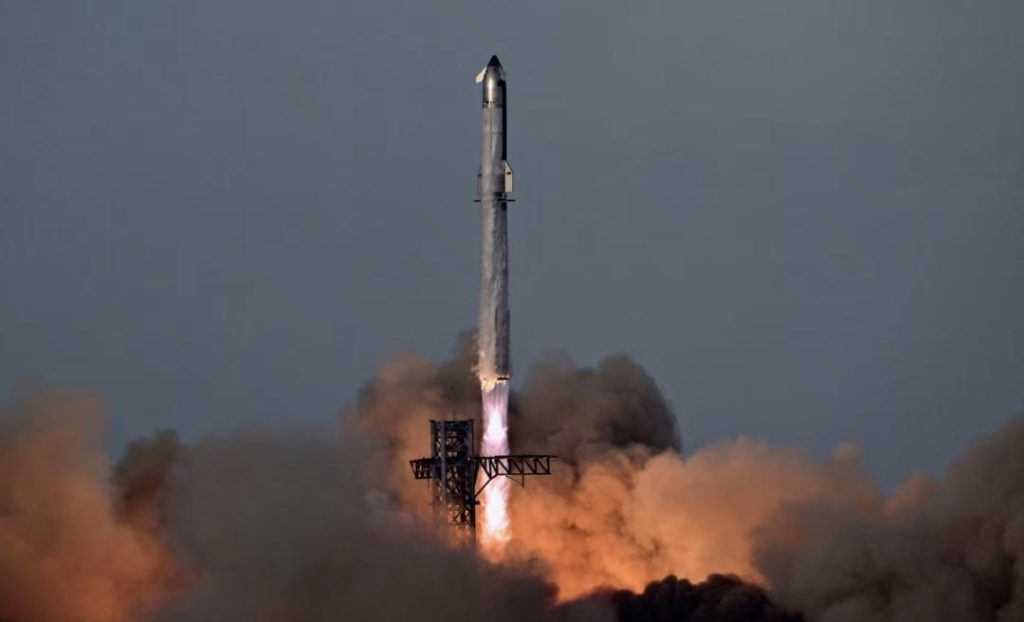
SpaceX’s Starship Deploys 8 Dummy Satellites on 10th Flight
SpaceX’s ambitious Starship program has taken a significant leap forward with the successful completion of its 10th test flight. On this milestone mission, the Starship rocket deployed a batch of eight dummy Starlink satellites in space, tested new heat shield tiles during re-entry into Earth’s atmosphere, and splashed down as planned in the Indian Ocean. Meanwhile, its Super Heavy booster targeted the Gulf of Mexico. This crucial test flight marks a major step towards SpaceX’s goal of developing a reusable spacecraft capable of taking humans to the moon and beyond.
The Starship, a behemoth of a rocket standing over 50 meters tall and 9 meters in diameter, lifted off from the company’s test facility in Boca Chica, Texas, at 10:30 AM CDT. The rocket, powered by its Raptor engines, reached an altitude of about 10 kilometers before deploying the dummy Starlink satellites. These satellites, designed to mimic the configuration and size of the actual Starlink satellites, were used to test the Starship’s deployment mechanism and ensure that it can accurately release payloads into orbit.
After deploying the satellites, the Starship began its descent back to Earth, using its heat shield tiles to withstand the intense heat generated during re-entry. This was a critical test for the spacecraft, as it needed to validate the effectiveness of its heat shield design in protecting the vehicle from the extreme temperatures it would encounter during atmospheric re-entry. The tiles, made of advanced materials, are designed to absorb and dissipate heat, allowing the Starship to survive the intense conditions and safely return to Earth.
Once the Starship had re-entered the atmosphere, it deployed its parachutes and splashed down in the Indian Ocean, as planned. The successful splashdown marked the end of the test flight, with the spacecraft recovering from the water with minimal damage.
Meanwhile, the Super Heavy booster, which is designed to provide the thrust needed to escape Earth’s gravitational pull and propel the Starship to orbit, targeted the Gulf of Mexico for its own splashdown. The booster’s successful recovery will be crucial for future Starship missions, as it will enable the spacecraft to return to Earth with its payload and be reused multiple times.
The success of this 10th test flight is a significant milestone for SpaceX, as it marks a major step towards the development of its reusable spacecraft. The Starship is designed to be capable of taking both people and cargo to the moon, Mars, and other destinations in the solar system, and this test flight has demonstrated its ability to deploy payloads and survive re-entry.
Notably, NASA has ordered two Starships to land astronauts on the moon later this decade, as part of its Artemis program. The Starship is being developed in collaboration with NASA, with the space agency providing funding and expertise to support the development of the spacecraft.
In a statement following the successful test flight, SpaceX CEO Elon Musk tweeted, “Starship successfully deployed 8 Starlink satellites and splashed down in the Indian Ocean. Next up, we’ll be testing the SN20 prototype with a crew capsule and advancing our mission to the moon and Mars.”
The success of this 10th test flight is a testament to the capabilities of the Starship program and its potential to revolutionize space travel. With its reusable design, advanced propulsion systems, and ability to deploy payloads, the Starship is poised to play a major role in the future of space exploration.






